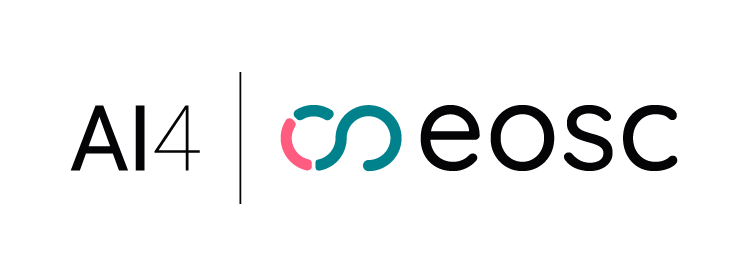This is a simple User Interface over models served through the DEEPaaS API. It only wraps the PREDICT method, for TRAIN you still have to go through the DEEPaaS API.
The motivation is to provide the end user with a friendlier interface than the Swagger UI. This UI is built with the Gradio package, that enables to easily create interfaces to any ML model (or any function for that matter).
Steps:
- run an AI module. Modules will (normally) by default launch the DEEPaaS API on port 5000.
- retrieve the internal network IP
- launch the UI
export CONTAINER_ID=$(docker run -ti -d -p 5000:5000 ai4oshub/ai4os-demo-app)
export DEEPAAS_IP=$(docker inspect -f '{{range .NetworkSettings.Networks}}{{.IPAddress}}{{end}}' $CONTAINER_ID)
docker run -p 80:80 -e DEEPAAS_IP=$DEEPAAS_IP registry.services.ai4os.eu/ai4os/deepaas_uiTo use it, first you need to run DEEPaaS with a module. If you don't have a module installed, consider running the lightweight demo_app to get the feeling of what the UI looks like.
pip install git+https://github.com/ai4os-hub/ai4os-demo-app.git
deepaas-run --listen-ip 0.0.0.0 --listen-port 5000Once you have the app running, you can deploy the UI:
git clone https://github.com/ai4os/deepaas_ui && cd deepaas_ui
pip install -r requirements.txt
python launch.py --api_url http://0.0.0.0:5000/ --ui_port 8000
⚠️ Additional requirements:If your model needs to needs tpm process video as input/output, Gradio needs an ffmpeg installation:
sudo apt install ffmpeg
- If several models are found in the API endpoint, it will only deploy an interface for the first model found (!).
- If you model returns a JSON, you should define a proper schema in order to get a fancy display in Gradio. Otherwise you will be shown the output as a plain dict in Gradio.
- If you want to return multimedia files in a JSON, they should be encoded as
base64. - If you are performing a classification, please return in that JSON the keys
labelsandpredictions(with the probabilities) to get a fancy classification display. - If you have image/video/audio in your input/output args, you have to use the webargs/marshmallow
Field()arg and provide theimage/video/audiokeyword in the arg description, in order for those to be nicely rendered by Gradio. Otherwise they will be rendered as plain files.
TODOs:
- ¿make the parsing of the API parameters recursive? (now we parse dtypes for the first level of the json only)
- support annotated image?
- change tab name to "AI4EOSC UI" but this implies using Blocks which make the code uglier
Initially Gradio 2.3.9 was used. It worked fine in most cases.
But it could not work when a module offers more than one possible choice of accept MIME in the response. This happens because the Gradio interface is generated before the accept parameter is defined by the user (when calling predict()). The only possible solution was to fix the accept type, thus not letting the user to decide the response type.
However this could be fixed starting from version 3.0 through the use of Gradio Tabs. So we could basically create a different Tab for each MIME. But 3.0 only works for Python 3.7+ due to this.
Given that, at the time of this decision (July 2024), Python 3.7 has reached it's end of life support, we take the decision to move to Gradio 4.37.2 (compatible with Python 3.8.8).
This implies that old modules will no longer be compatible with latest deepaas-ui. We leave nevertheless a backward compatible version just in case (branch backward-compatible), though it is very outdated.
The DEEPaaS UI is deployed in the platform as a "Try-me" endpoints in PAPI. The Nomad job to deploy it can be configured in two ways:
- Install DEEPaaS UI on top of the user container (that contains DEEPaaS)
- Launch the DEEPaaS UI as a sidecar task, in its own container.
Pros and cons:
-
- consumes less resources because the resources are shared between the user container and the mode
-
- offers less fault-tolerance because we cannot control the environment in which the UI will be running (it depends on the user container)
-
- is faster to deploy because we don't have to install anything in the user container. Otherwise we always have install the same packages each time we make a deployment. This is especially important because those are meant to be endpoints for quick tries.
We ended up going with option 2, especially since installing ffmpeg became kind of mandatory. For archival purposes, as option 2 was the initial approach, we provide:
- the Nomad job
- the bash script used to install the UI on top of the user's container
All the best practices can be seen in the demo_app API implementation. Here is how the UI looks like (left-hand side are inputs, right-hand side are outputs):


